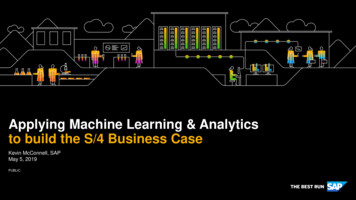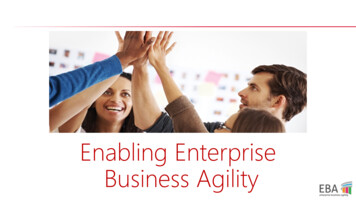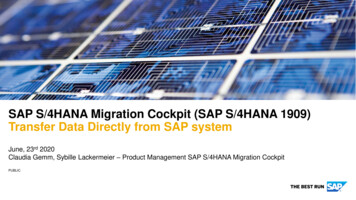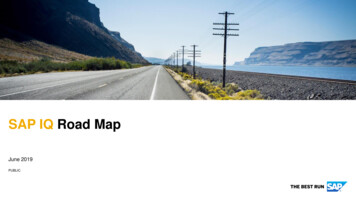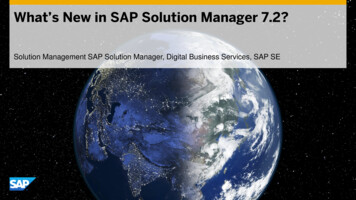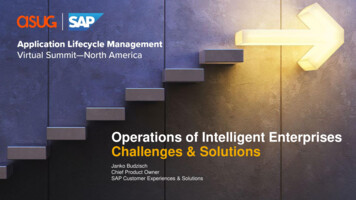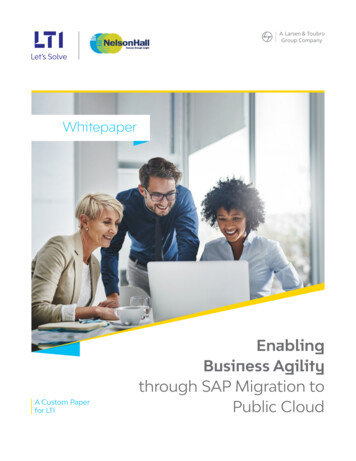
Transcription
WhitepaperA Custom Paperfor LTIEnablingBusiness Agilitythrough SAP Migration toPublic Cloud
Table ofContents105LTI SAP Cloud MigrationApproach2LTI SAP Cloud MigrationOfferingsA. Migration ToolsB. Industry-specific offerings3512LTI SAP Cloud MigrationDelivery Capabilities4North America, Manufacturing& Retail Lead AdoptionIncreasing Automation WillEnhance Ability to Scale6071314Summary15
03The Public Cloudenables generatingincreased valuefrom SAPThe overall SAP ecosystem remains dominatedUtilization: Sizing of infrastructure is aby on-premise installations with only achallenge and it isn’t until after go-live thatminority of SAP systems currently hosted onhardware is oversized.cloud. Even where SAP systems are hosted oncloud, this tends to be a private cloud ratherthan public cloud. NelsonHall estimates that 35% of S/4HANA implementations to datehave been on the cloud, the majority beingLimitation on Automation: On-premiseinfrastructure limits the ability to applyautomation in the operations and maintenanceof SAP, increasing cost.hosted on private clouds and a minorityDisaster Recovery: SAP customers cannothosted in public clouds such as AWS, Azureafford a second datacenter for disasterand Google Cloud Platform.recovery and tend to rely on old-style tapeOn-premise hosting of SAP can limit thebackup.value of upgrading to or adopting SAP andScalability: Limited ability to scale rapidly toS/4HANA. Specific examples of areassupport changing business needs and growth.where on-premise impacts the overallvalue case includes:Compute Capacity Lock-in: Dev, Test and QAenvironments are primarily only busy duringHardware Cost: The cost of procuring,the implementation and can then be idledstanding up and maintaining traditional server,after go-live; but environment costs arestorage, and network hardware withlocked-in at the peak capacity requirement.backup/HA solutions.
04These challenges and the greater maturity ofSystems can scale up, out or downhyperscale cloud providers are driving thedepending on system workloadincreased demand for hosting SAP on therequirements.cloud. Over the last few years, this has begunto accelerate with 60% of IT service buyersidentifying increased agility of core productionsystems such as ERP as a very high priority inMany administration activities can beautomated to enable IT to focus on morestrategic tasks.2020, and organizations are increasinglyDR environment can be quickly set uplooking to take advantage of the incrementalwithout affecting existing productioncost and flexibility of using a public cloudenvironment.provider (particularly when upgrading toS/4HANA and implementing associatedcapabilities). Cloud provides a simpler avenuefor adopting many of the incrementalDev/Test/QA environments can be“parked”, once the implementation iscompleted to minimize compute costs.capabilities that drive the value of S/4HANA,To support the expected increasing demandsuch as adding analytics, IoT and AI/MLfor these services, LTI is focusing on buildingcapabilities, or other SAP cloud products (suchthe following capabilities:as Ariba and Hybris).A broad set of migration tools tailored toLTI is focusing on enabling this growingthe specific needs of SAP and public cloud.interest in adopting a public cloud for SAP. Toenable its clients to accelerate the entire SAPIndustry-tailored offerings to acceleratelifecycle on cloud, LTI is leveraging twovalue realization in targeted verticals.decades of SAP experience, and 50purpose-built tools. LTI estimates that usingpublic cloud can help clients realize a 40-70%Converged delivery capabilities andautomated toolsets.operating cost savings over hosting anequivalent ecosystem on-premise.To enable its clients to realize valueHosting SAP in a hyperscale environmentfrom migrating SAP to a cloudhelps to address many of the costenvironment while accelerating andchallenges of on-premise, including:de-risking the migration process, LTILimited up-front infrastructure capitalexpenditures to stand up newinfrastructure in the cloud with built-in highavailability/disaster recovery functionality.has developed a standardizedapproach, and a breadth ofofferings supported by foundationaldelivery capabilities.
051LTI SAP CloudMigration ApproachLTI has developed a standard multi-phase approach to assess, plan, migrate and support a client’s SAPsolution to the public cloud. This approach is underpinned by four key imperatives that LTI views as criticalto the client’s migration success:Transform-as-youMigrate:Minimal BusinessImpact:WorkloadPrioritization:Identify and eliminatethe unused systemsduring migration,while doingtechnologymodernization.Understand businessuser personas, theirbusiness cycles, andmanage userexperience.Prioritize workloadmigration using LTI’s3D approach of Risk,Complexity &Business Impact.Right size target &OptimizePerformance:Optimize instancesand provisioning byunderstanding usagepatterns.
06The first phase of the approach is a cloudsuitability assessment to understand the currentstate of the client’s SAP landscape and gauge thesuitability, impact and complexity of migratingeach component to a public cloud environment.Specific tasks include:The second phase of the program focuseson the detailed profiling of the SAP technicallandscape. This includes analysis of:The third phase is theReview current SAP LandscapeBusiness Impact AssessmentApplication portfolio analysisagainst factorsSAP landscape architectureSAP system sizing for cloudStrategy for standalone & less critical instances to cloudprocess of developing andStrategy for integrated units in planned cutoverexecuting the migrationstrategy. This strategy isSAP Application downtime & cutover strategydesigned to span allcomponents andHA/DR strategyconsiderations for theRecovery strategymigration including:Finally, once the migration has been completed successfully, LTI offers the on-going maintenance andsupport of the SAP environment, including:1Post-migration support.2Technical decommissioning as required.
072LTI SAP CloudMigration OfferingsA. Migration ToolsBy merging its cloud migration and SAP capabilities, LTI has developed a toolset to support this approachto shifting from an on-premise SAP landscape to a cloud-based one, which it has used across a broad setof clients, including Fortune 500 companies.LTI has developed a broad toolset to aid clients on this journey, regardless of the path taken. Specific toolsinclude:S/4HANA SmartAnalyzerCloudRapidAdoptMigExpressMigration SuiteCloud ValueX-Ray
08S/4HANA Smart AnalyzerClients looking to adopt cloud are frequently, in parallel, looking to migrate legacy SAP instances to HANAor S/4HANA. To enable this, LTI uses its S/4HANA Smart Analyzer to identify necessary configurationchanges and custom code modifications required to operate in a S/4HANA cloud solution. It is deployedas part of a consulting engagement and extracts information enabling LTI to analyze an existing ERPsystem over the course of a three-week engagement.Smart Analyzer looks at the functionality and processes implemented in the current system to assess theimpact of migrating to S/4HANA. This includes analysis of:Custom objects impactedAdd-on functionality not currentlysupported by core S/4HANAData needing to be cleansed before conversionLanguages not supportedProcesses that need to be addressed, including the following: Master data management Finance and control Procure-to-pay Production planning Order-to-cashSmart Analyzer uses this information to develop a roadmap for adoption. It supports the development ofa business case by identifying the process and performance impact of migrating to S/4HANA. It also looksat user experience changes that can be realized through the adoption of Fiori applications.LTI supports its clients through three distinct adoption approaches: Greenfield approach, standing up anew SAP environment consisting of standard processes and objects and migrated data; Brownfieldapproach of migrating the existing custom processes, objects and data, or a hybrid, Bluefield approach.LTI is primarily witnessing the clients choose to re-implement S/4HANA as a Greenfield solution in thecloud rather than trying to migrate a customized, legacy SAP landscape. It estimates 60% of its clientshave chosen this adoption path.For clients that do choose to migrate existing instances, however, LTI uses tailored versions of its cloudmigration toolset, RapidAdopt and MigExpress, which can use ingested data from Smart Analyzer todevelop the migration plan.
09Cloud RapidAdoptCloud RapidAdopt is a cloud assessment tool that enables fast-track adoption of various cloud solutionsand is designed to be cloud-agnostic. Specific capabilities include:Cloud knowledge fabric: Metrics that measure how a target application would operate in a cloudenvironment. LTI currently uses 17k metrics to analyze applications.Discovery and dependencyframework: A standard framework for developing an in-depth understanding of the application portfolioto inform how best to migrate each application and where it should reside.Knowledge map: Created by RapidAdopt, the knowledge map identifies the business functions,interdependencies, and interactions across the application portfolio.Future state: Identifies what happens as each application migrates to the cloud.RapidAdopt is a proprietary framework built by LTI, based on commercially available products and opensource technologies. LTI estimates it has been used to assess a total of 1.5k applications, 45k servicesand 20PB of storage across its client base.MigExpress Migration SuiteFor workload migration, LTI has developed a set of tools called the LTI Cloud MigExpress Migration Suite.Rather than focusing on a single automated tool, it has curated a set of tools, assets, and processes.Specific migration activities that are targeted for completion by the MigExpress Suite include:Rehosting: Lift-and-shift of applications, including installing, deploying and reconfiguring applications.Replatforming: Lift-and-reshape of applications, including designing infrastructure, reconnectingapplication, and migrating data.Upgrading/re-installing packaged applications: Upgrading or remediating existing packagedapplications, including re-installing and re-configuring applications to operate in the cloud, and migratingand testing data.Re-architect customer applications: Re-architect and re-factor existing custom-developed applications,including re-writing, testing and deploying.
10In parallel to modifying the applications, LTI also looks to implement automation and DevOps to managethe future state hybrid environment.After an analysis of multiple migration tools available on the market, LTI selected tools to be included inthe Migration Suite that can replicate existing applications residing on-premise in virtual machines to anewly stood-up cloud environment.Additionally, LTI uses AWS/Azure Database Migration Service to support migrating client databases to acloud environment. The service supports homogenous migrations including Oracle to Oracle, as well asmigrations between different database platforms such as Oracle to Amazon Aurora or Microsoft SQLServer to MySQL. It also allows streaming data to Amazon Redshift, Amazon DynamoDB, and Amazon S3from any of the supported sources, including Amazon Aurora, PostgreSQL, MySQL, MariaDB, Oracle, SAPASE, SQL Server, and MongoDB.Cloud Value X-RayIn 2017, LTI developed its Cloud Value X-Ray tool, which is designed to help clients better understand theoperational cost implications of the defined cloud solution and then manage the multi-cloudenvironment. It is used in the planning stage of migration to optimize the cloud environment beingtargeted and then used to manage the cloud environment going forward. The Cloud Value X-Rayprovides the following services:Cost planner to define and manage cloud costsSavings maximizer to identify cost leaks in the target cloudenvironmentSmart chargeback to govern spend across the client’s businessClick-to-save to resolve cloud cost issuesUnified dashboard to visualize AWS and Azure cloudperformanceGovernance and ReportingReserved instance manager to manage cloud instances
11B. Industry-specific OfferingsIT service buyers have repeatedly shown that a key value they seek from their vendors is a deepunderstanding of their own industry. And, when it comes to cloud migration and ERP, buyers frequentlylook for vendors to understand how cloud adoption is best realized, based on the specific priorities orconstraints of a given industry. For SAP users, who are looking to potentially migrate to S/4HANA inaddition to migrating to the cloud, this includes prioritizing vendors that can deliver industry-specificfunctionality to augment core S/4HANA capabilities.In addition to its toolset that works across industry sectors, LTI has developed migration blueprints thataccelerate migrating specific SAP components to cloud environments. These are primarily delivered on SAPCloud Platform and are implemented as a SaaS solution, integrated to a core S/4HANA implementation.LTI has developed solutions for the industries, where it has seen early adoption of S/4HANA and thecloud, including:ManufacturingOil & GasEngineering & ConstructionIts manufacturing-focused offerings include enabling IoT capabilities, and LTI has already delivered this foran automotive client.One of its oil and gas offerings is a compliance system for EPA requirements, currently deployed at aUS-based oil refiner.Additionally, it is building horizontal solutions that address specific areas of need in these industries. Thesesolutions include intelligent asset management, smart supply chains, inventory optimization, finance offuture and an intelligent payment solution.
123LTI SAP Cloud MigrationDelivery CapabilitiesTo support the delivery of its offerings, LTI has invested in building a combined group that spans both SAPand cloud skills. The makeup of this team includes:12004.7kcloud specialists, including 350certified and 120 architectsSAP-skilled employees, 80% ofwhich are located in IndiaWithin its dedicated cloud team, it has identified a subset of specialized SAP experts that are dedicated tohelping clients with migrating SAP to cloud environments. That team is growing and currently has 150-200 people dedicated to SAP cloud engagements, with another 300 possessing SAP migrationexperience.In terms of key partnerships, LTI is a SAP Global Strategic Services Partner for S/4HANA, SAP GuidedOutcome Partner, delivery partner, re-seller, and client of SAP. The L&T Group (LTI's parent) has been aclient of SAP since 1992. LTI migrated its own internal SAP to S/4HANA in early 2017 and is in the processof a phased roll-out.LTI uses partnerships with public cloud providers to support the migration of SAP to the cloud, includingMicrosoft Azure, Google Cloud Platform and AWS.
134North America, Manufacturing& Retail Lead AdoptionLTI’s client footprint for SAP migration to the cloud totals 100 to date, and the mix of sectors andgeographies is similar to its broader client footprint.LTI has developed differentiated, focused and tailored approaches for each of North America and Europebased on the different priorities and profiles within each region.From an industry perspective, it estimates that 60% of its footprint comes from the following sThe most aggressive migrators of SAP to the cloud are based in the manufacturing and retail sectors.Beyond geography and sector, the greater determinant of migrating to the cloud is SAP footprint size.Mid-sized HANA landscapes (2k to 5k users, up to 10k users maximum) have the agility and willingness tomove to the cloud faster. This is particularly the case for SAP landscapes that are limited to a singleinstance dedicated to a single country.LTI’s clients that possess large, multi-instance landscapes have been much slower adopters. In addition tothe complexity and customizations inherent in a multi-instance, multi-location landscape, concernsaround risks such as data consolidation and regulatory constraints have acted as inhibitors.
145Increasing automation willenhance ability to scaleLTI is able to deliver these services today to enable clients to achieve aggressive timelines. As an example,it was able to complete a S/4HANA migration in two months, which included the migration of twoterabytes of data residing across 200 servers.Going forward, LTI is focusing on accelerating its delivery through increased automation. It has alreadybuilt automation for the installation of SAP, provisioning of infrastructure, and deploying applications intocloud environments. Now, it is focused on adding automation to the following:End-to-end SAP migrationSAP basis reconfigurationFunctional testLTI is investing in efforts to script and automate SAP-basis migration and post-migration validation testing.Rather than expanding the workforce to support greater SAP migration, it will use automation as a forcemultiplier, estimating that investments in automation technology will multiply its employee efficiency andeffectiveness by 400%.In addition to an expanded use of automation, when LTI looks ahead, it is focusing on two key areas tomature and evolve its capabilities: expanding the use of as-a-service contractual models and broadeningits portfolio of industry-specific solutions.
15To grow its as-a-service model footprint, it is leveraging its experience with Veolia, a French water, wasteand energy management company. LTI migrated a de-centralized SAP environment to a centrallymanaged AWS-hosted SAP environment. Operating the system is delivered as-a-service and the resultingsolution has improved performance while driving operating cost savings.LTI is also looking to build out more industry-specific solution and using a digital solution, it has builttargeting the engineering, construction and operations clients. This solution combines core S/4HANA withLTI proprietary solutions and IoT offerings from SAP Leonardo to integrate capabilities planning andexecution.SummaryThe convergence of SAP and public cloud offerings is quickly becoming beneficial for enterprises. Thebusiness case for adopting S/4HANA can be enhanced through the reduced infrastructure costsassociated with cloud, while migrating an ERP system provides a foundation for building a broaderenterprise-wide hybrid cloud landscape. LTI is tracking several different business objectives that canbe realized through the migration of SAP from on-premise to cloud. These include:12345Pivot of SAP infrastructure cost from CAPEX to OPEXImproved recovery times and rapid deployment of high availability solutionsIncreased speed for provisioning of SAP systems and time to marketSupport for enterprise digital transformation journey and adoption of HANAAbility to archive data and enabling the corresponding SAP systems to be audit-proofLTI has worked with clients across both SAP and cloud services and is now looking to sit at theforefront of their convergence. The integration of its SAP and cloud capabilities, combined with a focuson expanded use of automation in delivering these services, position LTI to support this rapidlygrowing client focus.
About NelsonHallAbout the AuthorNelsonHall is a global industry analyst firmDavid McIntire is an IT Services Research Directordedicated to helping organizationsat NelsonHall, with shared responsibility for ITunderstand the ‘art of the possible’ in ITServices research globally. David covers IT Servicesservices (ITS) and business process servicesin the areas of digital transformation, consulting(BPS), and specifically how to identify, adopt,and application services.and optimize the next generation of digitalHe has been a part of NelsonHall's IT Servicestechnology and services for their business.analyst team since 2016, providing comprehensiveand insightful coverage of IT services markets in theFounded in 1998, and with industry analysts inworld. In particular, he is recognized for histhe U.S., U.K., and Continental Europe,knowledge and coverage of digital transformationNelsonHall has a 20-year track record ofand application services. David assists bothproviding the highest quality market researchbuy-side and vendor organizations in assessingto both the buy-side and supply-side of theITS and BPS markets. All our research isopportunities and supplier capability across ITservice lines.onshore and in-house, and we are highlyvalued for both the insightfulness of ourresearch and the quality and ready accessibilityof our industry analyst inquiry/support service.DavidMcIntireYou can find out more about NelsonHall andits analysts, plus access the latest industryinsights at research.nelson-hall.com.LTI (NSE: LTI) is a global technology consulting and digital solutions company helping more than 420 clients succeed in a convergingworld. With operations in 32 countries, we go the extra mile for our clients and accelerate their digital transformation with LTI’s Mosaicplatform enabling their mobile, social, analytics, IoT and cloud journeys. Founded in 1997 as a subsidiary of Larsen & Toubro Limited, ourunique heritage gives us unrivalled real-world expertise to solve the most complex challenges of enterprises across all industries. Each day,our team of more than 30,000 LTItes enable our clients to improve the effectiveness of their business and technology operations anddeliver value to their customers, employees and shareholders. Find more at http://www.Lntinfotech.com or follow us at @LTI GlobalInfo@lntinfotech.com
new SAP environment consisting of standard processes and objects and migrated data; Brownfield approach of migrating the existing custom processes, objects and data, or a hybrid, Bluefield approach. LTI is primarily witnessing the clients choose to re-implement S/4HANA as a Greenfield solution in the




